engine RENAULT KANGOO 2016 X61 / 2.G Owner's Manual
[x] Cancel search | Manufacturer: RENAULT, Model Year: 2016, Model line: KANGOO, Model: RENAULT KANGOO 2016 X61 / 2.GPages: 173, PDF Size: 3.8 MB
Page 68 of 173
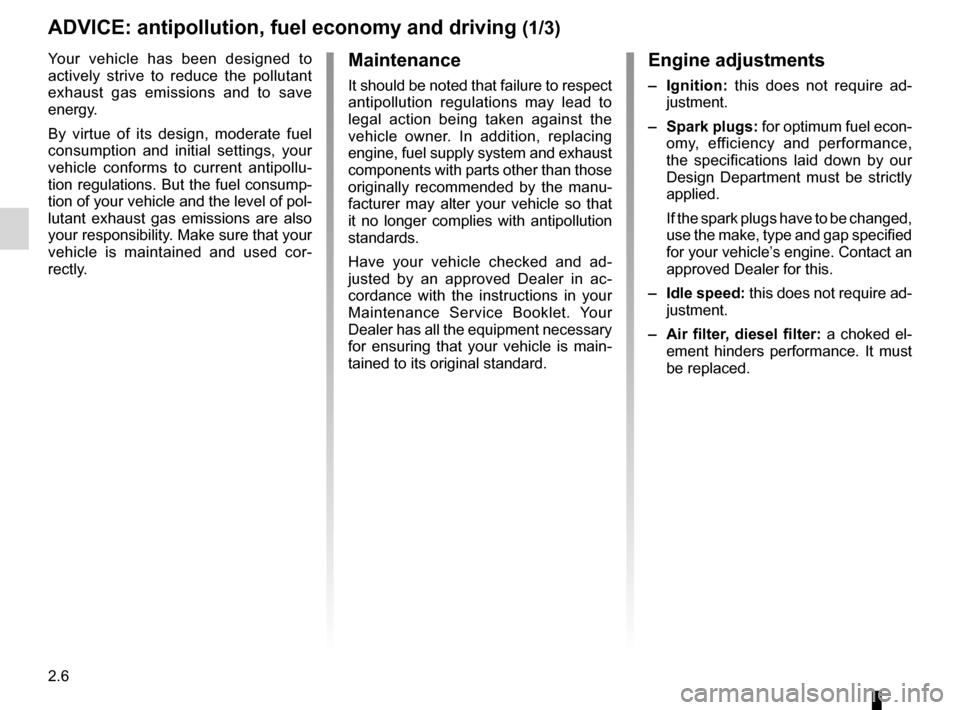
antipollutionadvice ............................................. (up to the end of the DU)
fuel advice on fuel economy .................. (up to the end of the DU)
advice on antipollution .......................... (up to the end of the DU)
fuel economy ........................................ (up to the end of the DU)
2.6
ENG_UD14000_2
Conseils antipollution, économies de carburant, conduite (X76 - Rena\
ult)
ENG_NU_854-2_X76LL_Renault_2
Jaune NoirNoir texte
Advice on antipollution, fuel economy and driving
ADvIcE: antipollution, fuel economy and driving (1/3)
Engine adjustments
– Ignition: this does not require ad-
justment.
–
Spark plugs: for optimum fuel econ-
omy, efficiency and performance,
the specifications laid down by our
Design Department must be strictly
applied.
If the spark plugs have to be changed,
use the make, type and gap specified
for your vehicle’s engine. Contact an
approved Dealer for this.
–
Idle speed: this does not require ad-
justment.
–
Air filter, diesel filter: a choked el-
ement hinders performance. It must
be replaced.
Maintenance
It should be noted that failure to respect
antipollution regulations may lead to
legal action being taken against the
vehicle owner. In addition, replacing
engine, fuel supply system and exhaust
components with parts other than those
originally recommended by the manu-
facturer may alter your vehicle so that
it no longer complies with antipollution
standards.
Have your vehicle checked and ad-
justed by an approved Dealer in ac-
cordance with the instructions in your
Maintenance Service Booklet. Your
Dealer has all the equipment necessary
for ensuring that your vehicle is main-
tained to its original standard.
Your vehicle has been designed to
actively strive to reduce the pollutant
exhaust gas emissions and to save
energy.
By virtue of its design, moderate fuel
consumption and initial settings, your
vehicle conforms to current antipollu-
tion regulations. But the fuel consump-
tion of your vehicle and the level of pol-
lutant exhaust gas emissions are also
your responsibility. Make sure that your
vehicle is maintained and used cor-
rectly.
Page 69 of 173
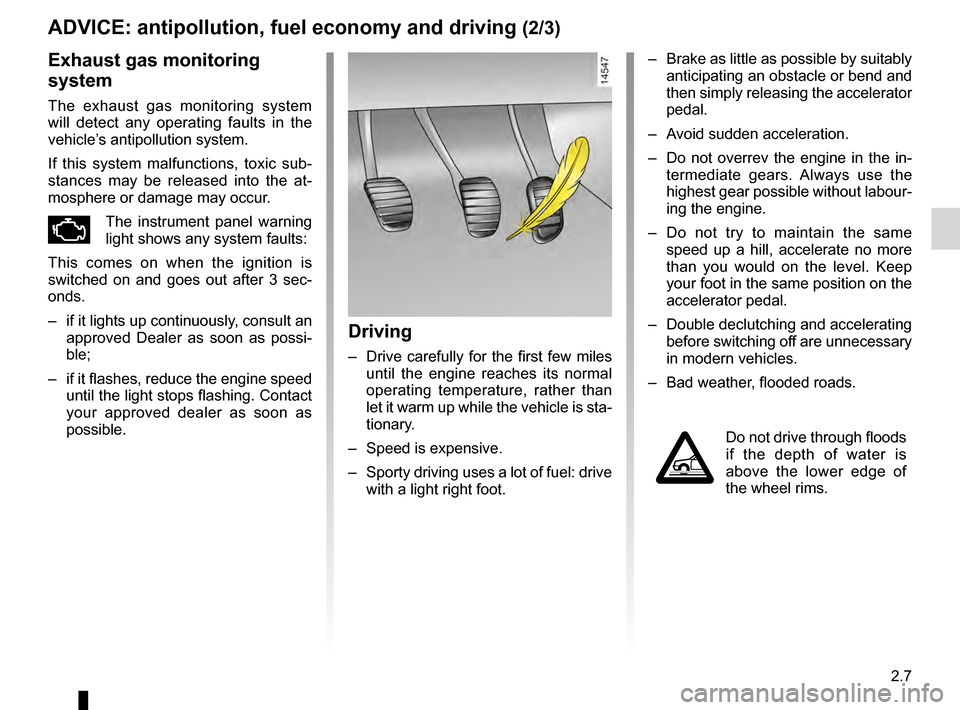
JauneNoirNoir texte
2.7
ENG_UD14000_2
Conseils antipollution, économies de carburant, conduite (X76 - Rena\
ult)
ENG_NU_854-2_X76LL_Renault_2
Exhaust gas monitoring
system
The exhaust gas monitoring system
will detect any operating faults in the
vehicle’s antipollution system.
If this system malfunctions, toxic sub-
stances may be released into the at-
mosphere or damage may occur.
ÄThe instrument panel warning
light shows any system faults:
This comes on when the ignition is
switched on and goes out after 3 sec-
onds.
–
if it lights up continuously, consult an
approved Dealer as soon as possi-
ble;
–
if it flashes, reduce the engine speed
until the light stops flashing. Contact
your approved dealer as soon as
possible.
ADvIcE: antipollution, fuel economy and driving (2/3)
Driving
– Drive carefully for the first few miles
until the engine reaches its normal
operating temperature, rather than
let it warm up while the vehicle is sta-
tionary.
–
Speed is expensive.
– Sporty driving uses a lot of fuel: drive
with a light right foot. –
Brake as little as possible by suitably
anticipating an obstacle or bend and
then simply releasing the accelerator
pedal.
–
Avoid sudden acceleration.
– Do not overrev the engine in the in -
termediate gears. Always use the
highest gear possible without labour-
ing the engine.
–
Do not try to maintain the same
speed up a hill, accelerate no more
than you would on the level. Keep
your foot in the same position on the
accelerator pedal.
–
Double declutching and accelerating
before switching off are unnecessary
in modern vehicles.
–
Bad weather, flooded roads.
Do not drive through floods
if the depth of water is
above the lower edge of
the wheel rims.
Page 70 of 173
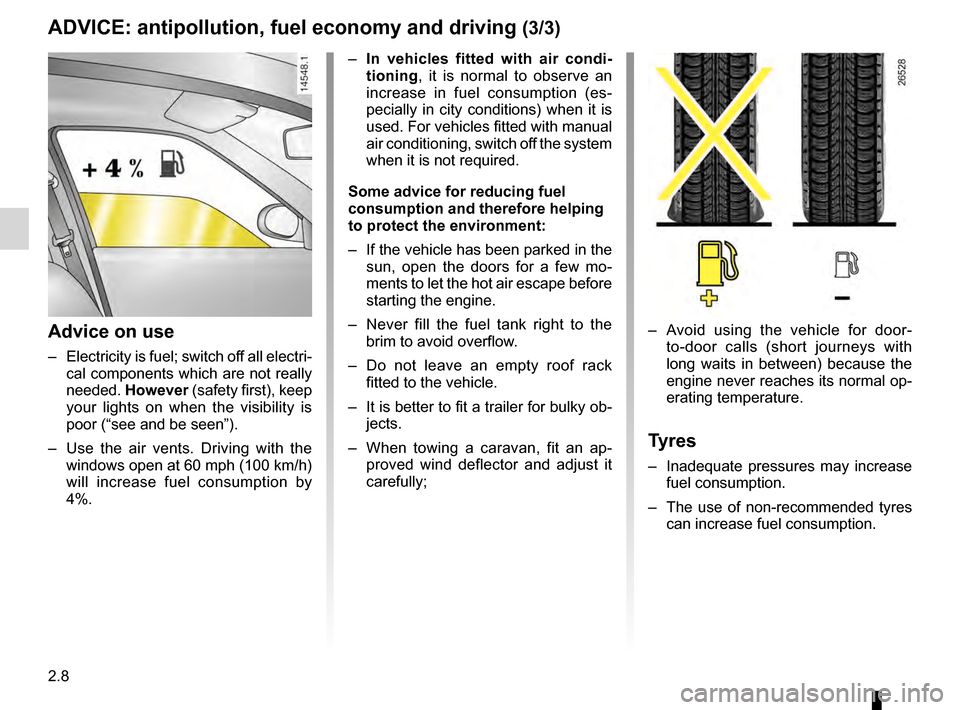
2.8
ENG_UD14000_2
Conseils antipollution, économies de carburant, conduite (X76 - Rena\
ult)
ENG_NU_854-2_X76LL_Renault_2
ADvIcE: antipollution, fuel economy and driving (3/3)
Advice on use
– Electricity is fuel; switch off all electri-
cal components which are not really
needed. h
owever (safety first), keep
your lights on when the visibility is
poor (“see and be seen”).
–
Use the air vents. Driving with the
windows open at 60 mph (100 km/h)
will increase fuel consumption by
4%. –
In vehicles fitted with air condi-
tioning , it is normal to observe an
increase in fuel consumption (es-
pecially in city conditions) when it is
used. For vehicles fitted with manual
air conditioning, switch off the system
when it is not required.
Some advice for reducing fuel
consumption and therefore helping
to protect the environment:
–
If the vehicle has been parked in the
sun, open the doors for a few mo-
ments to let the hot air escape before
starting the engine.
–
Never fill the fuel tank right to the
brim to avoid overflow.
–
Do not leave an empty roof rack
fitted to the vehicle.
–
It is better to fit a trailer for bulky ob -
jects.
–
When towing a caravan, fit an ap -
proved wind deflector and adjust it
carefully; –
Avoid using the vehicle for door -
to-door calls (short journeys with
long waits in between) because the
engine never reaches its normal op-
erating temperature.
t yres
– Inadequate pressures may increase
fuel consumption.
–
The use of non-recommended tyres
can increase fuel consumption.
Page 78 of 173
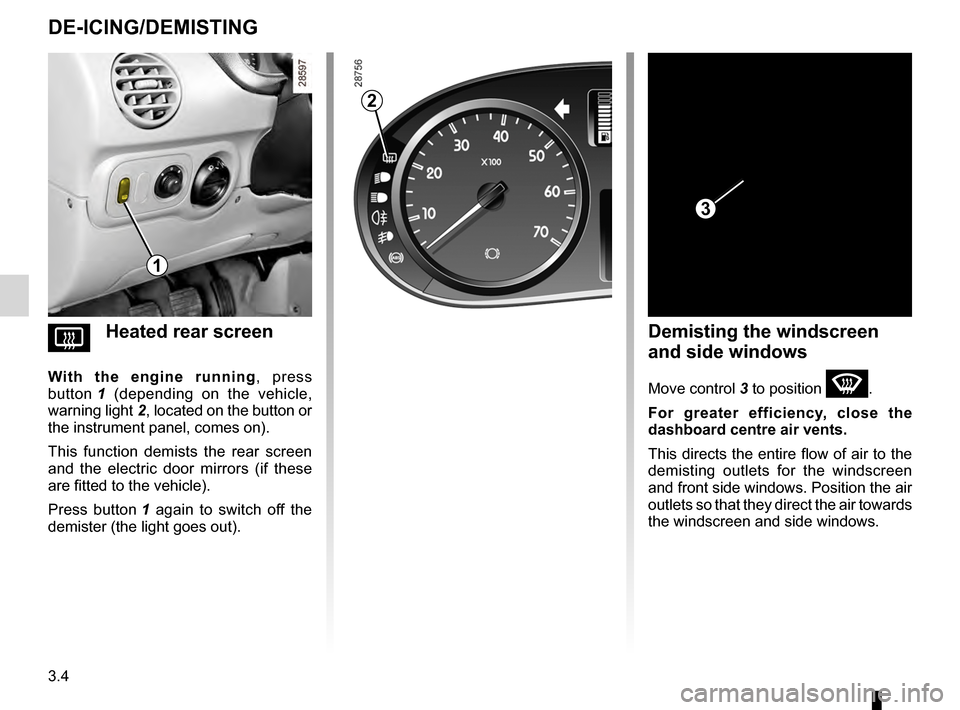
rear screen de-icing/demisting ............. (up to the end of the DU)
windscreen de-icing/demisting ............. (up to the end of the DU)
3.4
ENG_UD7268_1
Dégivrage / Désembuage (X76 - Renault)
ENG_NU_854-2_X76LL_Renault_3
Rear screen and windscreen de-icing and demisting
Demisting the windscreen
and side windows
Move control 3 to position W.
For greater efficiency, close the
dashboard centre air vents.
This directs the entire flow of air to the
demisting outlets for the windscreen
and front side windows. Position the air
outlets so that they direct the air towards
the windscreen and side windows.
VHeated rear screen
With the engine running , press
b
utton 1 (depending on the vehicle,
warning
light 2, located on the button or
the instrument panel, comes on).
This function demists the rear screen
and the electric door mirrors (if these
are fitted to the vehicle).
P
ress button 1 again to switch off the
demister (the light goes out).
De-iCinG/DeMistinG
3
1
2
Page 83 of 173
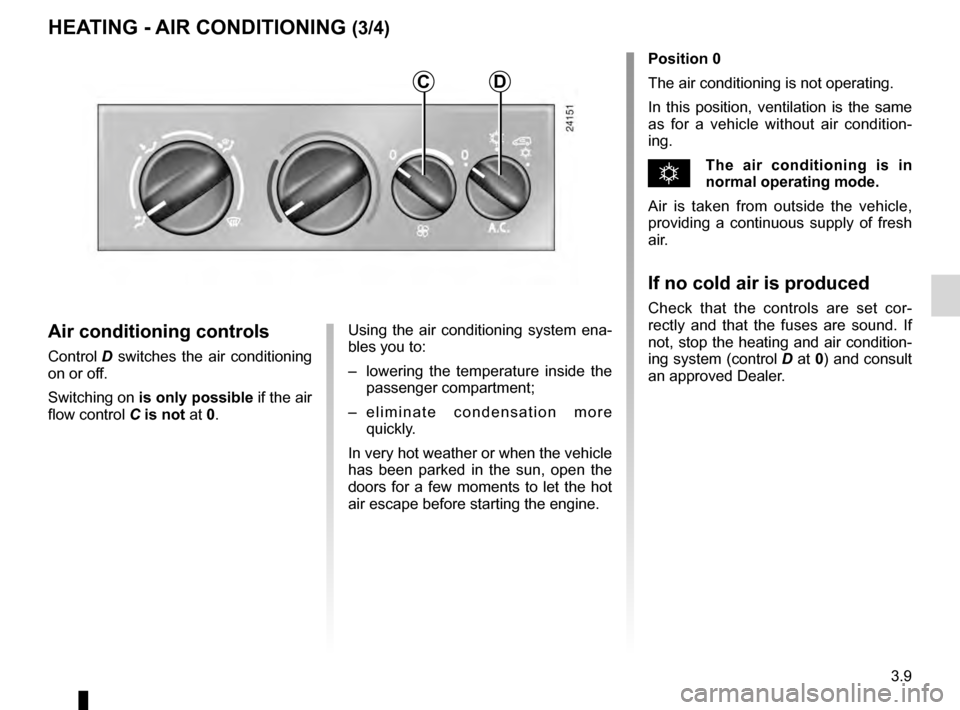
JauneNoirNoir texte
3.9
ENG_UD7290_1
Air conditionné (X76 - Renault)
ENG_NU_854-2_X76LL_Renault_3
HeA tinG - Air COnDitiOninG (3/4)
Position 0
The air conditioning is not operating.
In this position, ventilation is the same
as for a vehicle without air condition-
ing.
Ñthe air conditioning is in
normal operating mode.
Air is taken from outside the vehicle,
providing a continuous supply of fresh
air.
if no cold air is produced
Check that the controls are set cor-
rectly and that the fuses are sound. If
not, stop the heating and air condition-
ing
system (control D at 0) and consult
an approved Dealer.Air conditioning controls
Control D switches the air conditioning
on or off.
Switching on is only possible if the air
flow control
C is not at 0.
Using the air conditioning system ena-
bles you to:
–
lowering the temperature inside the
passenger compartment;
–
e l i m i n a t e c o n d e n s a t i o n m o r e
quickly.
In very hot weather or when the vehicle
has been parked in the sun, open the
doors for a few moments to let the hot
air escape before starting the engine.
CD
Page 85 of 173
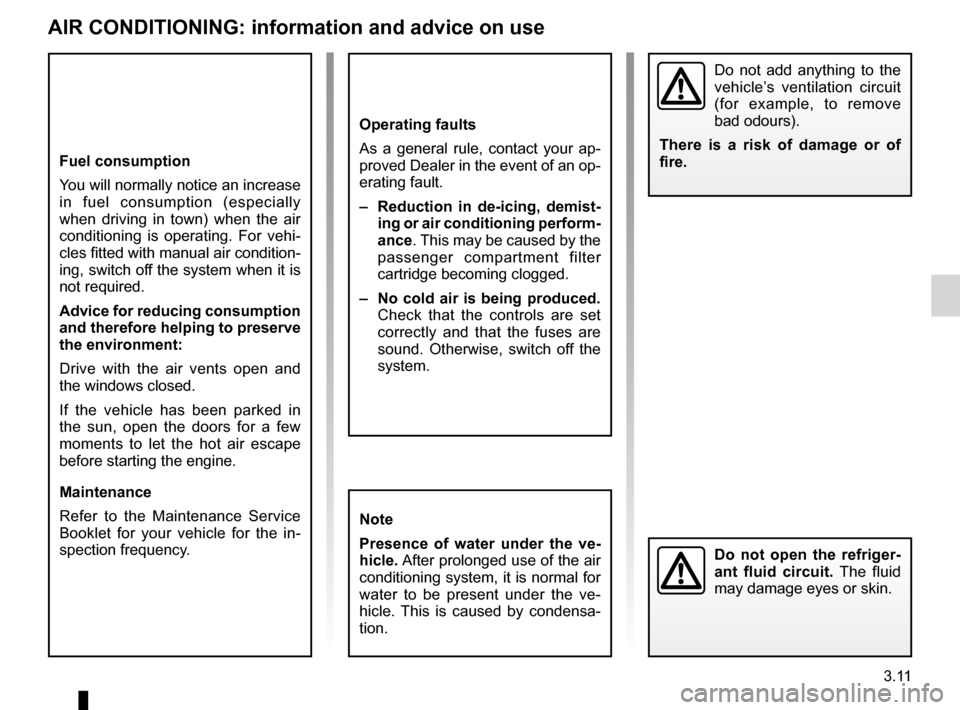
air conditioning ..................................... (up to the end of the DU)
heating system ..................................... (up to the end of the DU)
air conditioning ..................................... (up to the end of the DU)
temperature regulation ......................... (up to the end of the DU)
ventilation ............................................. (up to the end of the DU)
heating and air conditioning system ...................... (current page) 3.11
ENG_UD11524_2
Air conditionné : informations et conseils d’utilisation (X77 ph2\
- Renault)
ENG_NU_854-2_X76LL_Renault_3
Air COnDitiOninG: information and advice on use
Fuel consumption
You will normally notice an increase
in fuel consumption (especially
when driving in town) when the air
conditioning is operating. For vehi-
cles fitted with manual air condition-
ing, switch off the system when it is
not required.
Advice for reducing consumption
and therefore helping to preserve
the environment:
Drive with the air vents open and
the windows closed.
If the vehicle has been parked in
the sun, open the doors for a few
moments to let the hot air escape
before starting the engine.
Maintenance
Refer to the Maintenance Service
Booklet for your vehicle for the in-
spection frequency.
Do not open the refriger-
ant fluid circuit. The fluid
may damage eyes or skin.
note
Presence of water under the ve-
hicle. After prolonged use of the air
conditioning system, it is normal for
water to be present under the ve-
hicle. This is caused by condensa-
tion.
Operating faults
As a general rule, contact your ap-
proved Dealer in the event of an op-
erating fault.
–
r eduction in de-icing, demist -
ing or air conditioning perform-
ance. This may be caused by the
passenger compartment filter
cartridge becoming clogged.
–
no cold air is being produced.
Check that the controls are set
correctly and that the fuses are
sound. Otherwise, switch off the
system.
Do not add anything to the
vehicle’s ventilation circuit
(for example, to remove
bad odours).
t h
ere is a risk of damage or of
fire.
Page 88 of 173
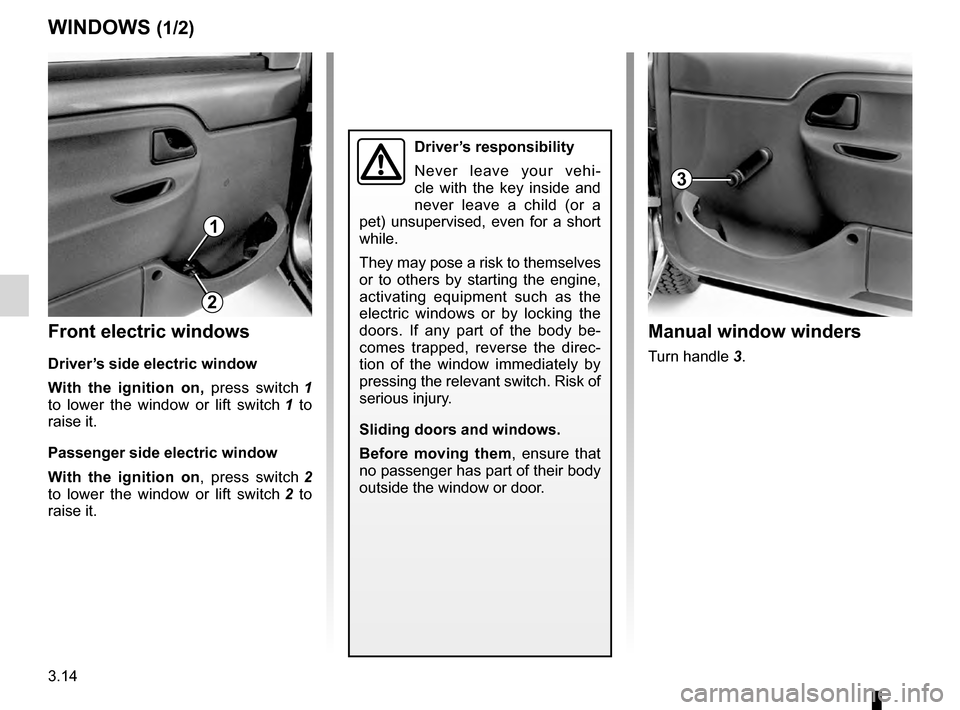
children .................................................................. (current page)
electric windows ................................... (up to the end of the DU)
child safety............................................................. (current page)
3.14
ENG_UD14027_2
Vitres (X76 - Renault)ENG_NU_854-2_X76LL_Renault_3
Jaune NoirNoir texte
Windows
Manual window winders
Turn handle 3.
Front electric windows
Driver’s side electric window
With the ignition on,
press switch 1
t
o lower the window or lift switch 1 to
raise it.
Passenger side electric window
With the ignition on ,
press switch 2
t
o lower the window or lift switch 2 to
raise it.
WinDOWs (1/2)
1
2
3
Driver’s responsibility
Never leave your vehi-
cle with the key inside and
never leave a child (or a
pet) unsupervised, even for a short
while.
They may pose a risk to themselves
or to others by starting the engine,
activating equipment such as the
electric windows or by locking the
doors. If any part of the body be-
comes trapped, reverse the direc-
tion of the window immediately by
pressing the relevant switch. Risk of
serious injury.
s
liding doors and windows.
Before moving them , ensure that
no passenger has part of their body
outside the window or door.
Page 99 of 173
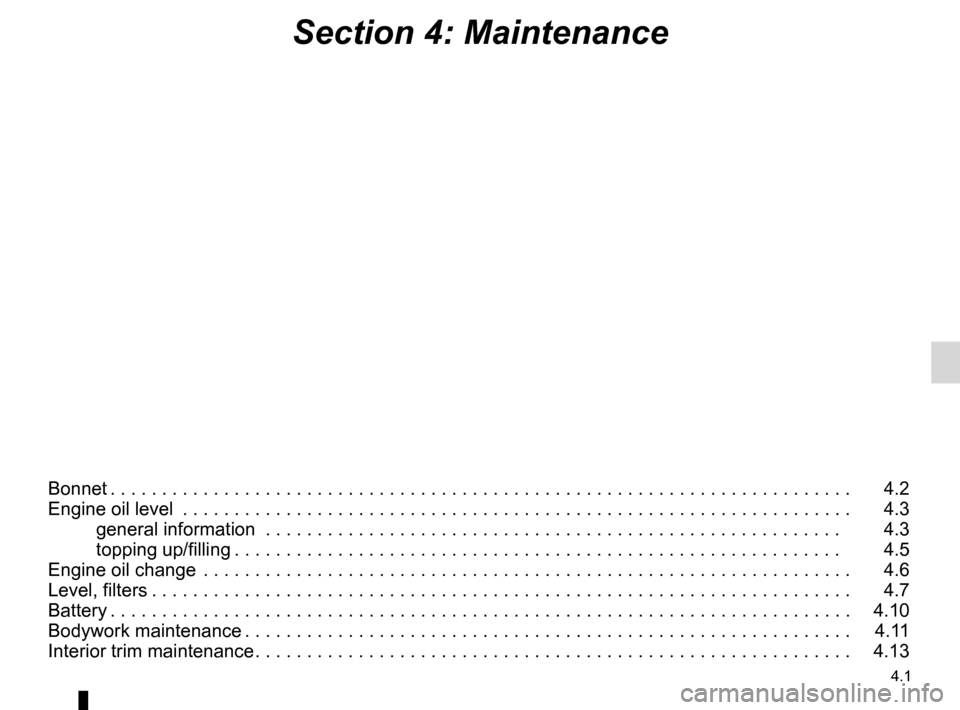
4.1
ENG_UD14021_2
Sommaire 4 (X76 - Renault)
ENG_NU_854-2_X76LL_Renault_4
Section 4: Maintenance
Bonnet . . . . . . . . . . . . . . . . . . . . . . . . . . . . . . . . . . . . \
. . . . . . . . . . . . . . . . . . . . . . . . . . . . . . . . . . . . 4.2
Engine oil level . . . . . . . . . . . . . . . . . . . . . . . . . . . . . . . . . . . .\
. . . . . . . . . . . . . . . . . . . . . . . . . . . . . 4.3
general information . . . . . . . . . . . . . . . . . . . . . . . . . . . . . . . . . . . .\
. . . . . . . . . . . . . . . . . . . . 4.3
topping up/filling . . . . . . . . . . . . . . . . . . . . . . . . . . . . . . . . . . . . \
. . . . . . . . . . . . . . . . . . . . . . . 4.5
Engine oil change . . . . . . . . . . . . . . . . . . . . . . . . . . . . . . . . . . . .\
. . . . . . . . . . . . . . . . . . . . . . . . . . . 4.6
Level, filters . . . . . . . . . . . . . . . . . . . . . . . . . . . . . . . . . . . . \
. . . . . . . . . . . . . . . . . . . . . . . . . . . . . . . . 4.7
Battery . . . . . . . . . . . . . . . . . . . . . . . . . . . . . . . . . . . . \
. . . . . . . . . . . . . . . . . . . . . . . . . . . . . . . . . . . . 4.10
Bodywork maintenance . . . . . . . . . . . . . . . . . . . . . . . . . . . . . . . . . . . . \
. . . . . . . . . . . . . . . . . . . . . . . 4.1
1
Interior trim maintenance . . . . . . . . . . . . . . . . . . . . . . . . . . . . . . . . . . . . \
. . . . . . . . . . . . . . . . . . . . . . 4.13
Page 100 of 173
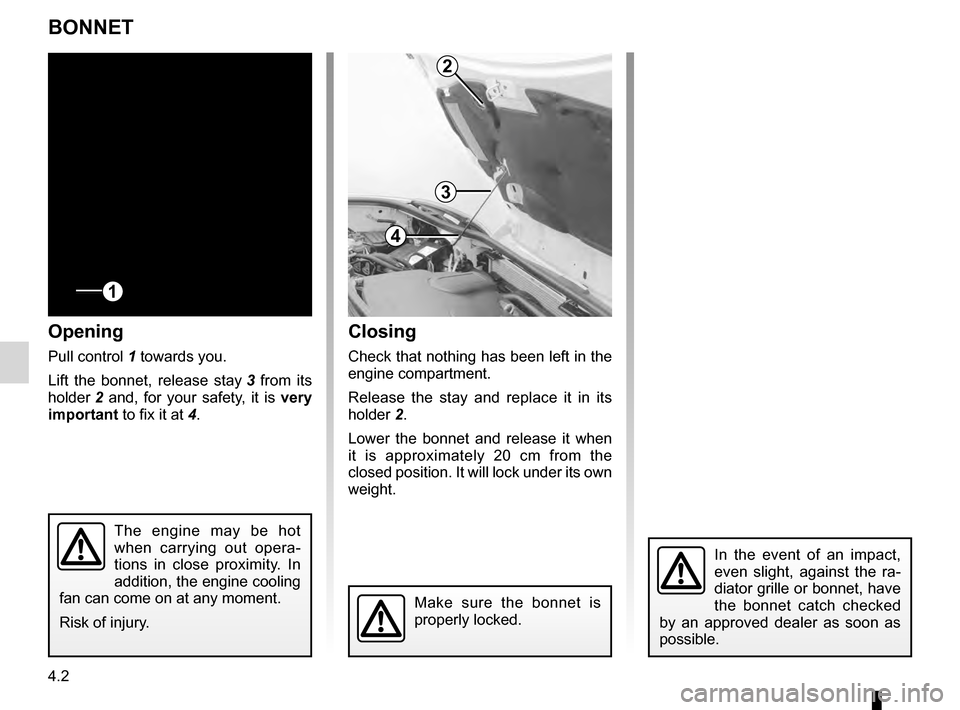
bonnet................................................... (up to the end of the DU)
maintenance:mechanical ...................................... (up to the end of the DU)
4.2
ENG_UD7306_1
Capot moteur (X76 - Renault)
ENG_NU_854-2_X76LL_Renault_4
Bonnet
Closing
Check that nothing has been left in the
engine compartment.
Release the stay and replace it in its
holder
2.
Lower the bonnet and release it when
it is approximately 20 cm from the
closed position. It will lock under its own
weight.
Opening
Pull control 1 towards you.
L
ift the bonnet, release stay 3 from its
holder
2 and, for your safety, it is very
important to fix it at
4.
BOnnet
1
2
3
4
The engine may be hot
when carrying out opera-
tions in close proximity. In
addition, the engine cooling
fan can come on at any moment.
Risk of injury.
In the event of an impact,
even slight, against the ra-
diator grille or bonnet, have
the bonnet catch checked
by an approved dealer as soon as
possible.
Make sure the bonnet is
properly locked.
Page 101 of 173
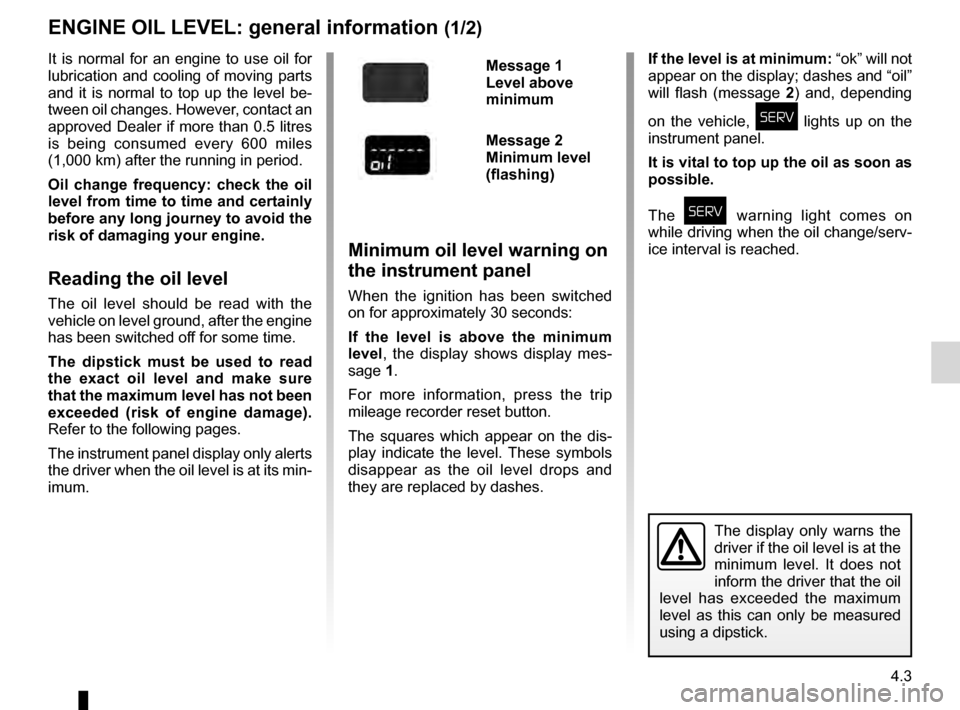
maintenance:mechanical ...................................... (up to the end of the DU)
engine oil .............................................. (up to the end of the DU)
dipstick.................................................. (up to the end of the DU)
engine oil level ...................................... (up to the end of the DU) 4.3
ENG_UD13985_2
Niveau huile moteur (X76 - Renault)
ENG_NU_854-2_X76LL_Renault_4
Engine oil level
general information
If the level is at minimum: “ok” will not
appear on the display; dashes and “oil”
will flash (message 2) and, depending
on the vehicle,
ø lights up on the
instrument panel.
It is vital to top up the oil as soon as
possible.
The
ø warning light comes on
while driving when the oil change/serv-
ice interval is reached.
Message 1
Level above
minimum
Message 2
Minimum level
(flashing)
Minimum oil level warning on
the instrument panel
When the ignition has been switched
on for approximately 30 seconds:
If the level is above the minimum
level , the display shows display mes-
sage
1.
For more information, press the trip
mileage recorder reset button.
The squares which appear on the dis-
play indicate the level. These symbols
disappear as the oil level drops and
they are replaced by dashes.
engIne OIL LeveL: general information (1/2)
The display only warns the
driver if the oil level is at the
minimum level. It does not
inform the driver that the oil
level has exceeded the maximum
level as this can only be measured
using a dipstick.
It is normal for an engine to use oil for
lubrication and cooling of moving parts
and it is normal to top up the level be-
tween oil changes. However, contact an
approved Dealer if more than 0.5 litres
is being consumed every 600 miles
(1,000 km) after the running in period.
Oil change frequency: check the oil
level from time to time and certainly
before any long journey to avoid the
risk of damaging your engine.
Reading the oil level
The oil level should be read with the
vehicle on level ground, after the engine
has been switched off for some time.
t h
e dipstick must be used to read
the exact oil level and make sure
that the maximum level has not been
exceeded (risk of engine damage).
Refer to the following pages.
The instrument panel display only alerts
the driver when the oil level is at its min-
imum.